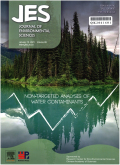Characterization of disinfection byproduct formation potential in 13 source waters in China
摘要:
The formation potential of four trihalomethanes (THMFP) and seven haloacetic acids (HAAFP) in 13 source waters taken from four major water basin areas in China was evaluated using the simulated distribution system (SDS) chlorination method. The specific ultraviolet absorbance (SUVA: the ratio of UV to dissolved organic carbon (DOC)), which ranged between 0.9 and 5.0 L/(mg·m), showed that the organic compounds in different source waters exhibited different reactivities with chlorine. The HAAFP of source waters ranged from 20 to 448 μg/L and the THMFP ranged from 29 to 259 μg/L. The HAAFP concentrations were higher than the THMFP concentrations in all but one of the samples. Therefore, the risks of haloacetic acids (HAAs) should be of concern in some source waters. TCM (chloroform) and BDCM (bromodichloromethane) were the major THM constituents, while TCAA (trichloroacetic acid) and DCAA (dichloroacetic acid) were the major HAA species. Br-THM (brominated THM species) were much higher than Br-HAA (brominated HAA species), and the formation of Br-DBP (Br-THM and Br-HAA) should be of concern when the bromide concentration is over 100 μg/L.
展开
关键词:
disinfection byproduct formation potential trihalomethanes haloacetic acids bromine substitute factor
DOI:
10.1016/S1001-0742(10)60440-8
被引量:
年份:
2011
通过文献互助平台发起求助,成功后即可免费获取论文全文。
相似文献
参考文献
引证文献
辅助模式
引用
文献可以批量引用啦~
欢迎点我试用!



